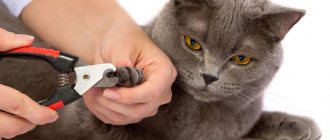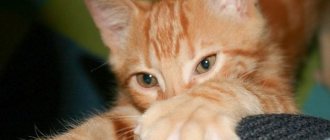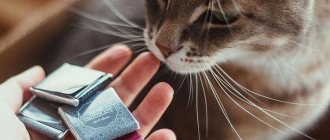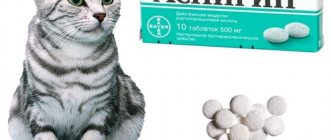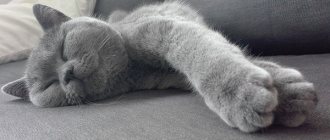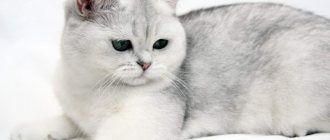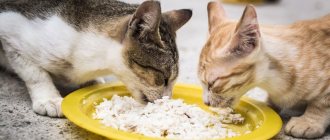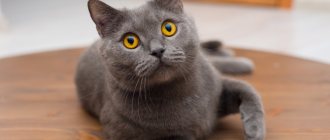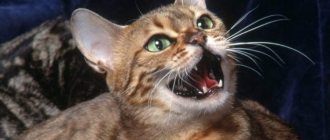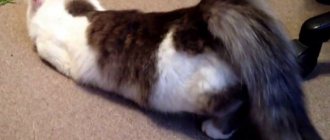When a cat appears in the house, owners are faced with many questions about caring for them, and especially their fur. Grooming British cats will help avoid a common problem in this breed - the formation of a hairball in the intestines. Due to their dense fur, when licking themselves, they swallow falling hairs, which later form this lump. Of course, visiting grooming salons is a controversial issue among owners, as some consider it abuse of animals, while others, on the contrary, believe that this is a necessary procedure for caring for a pet.
Why do you need to cut your cat's hair?
The main reason why a cat needs a haircut is mats.
They can cause serious harm to the animal's health.
- Firstly, the matted fur tightens the kitty's skin, causing it pain and discomfort. As a result, the cat may become nervous and not allow itself to be petted.
- Secondly, in places where tangles form, blood flow and heat exchange are disrupted. Naturally, such conditions are ideal for the proliferation of all kinds of pathogenic bacteria and fungi. The animal's skin may become very inflamed, itchy and flaky.
This article will tell you what to do if your cat’s hair falls out and bald spots form.
During daily licking, cats eat a lot of their fur, which can harm their digestion. To avoid problems, regular grooming of cats is necessary.
- Thirdly, a kitty may try so hard to get rid of tangles on her own that she will injure herself. A side effect of such diligence can also be eating a large amount of wool, which becomes a lump in the stomach, causing vomiting or, even worse, clogging the passages in the digestive tract. In the latter case, you cannot do without the help of a veterinarian. A cat also eats a lot of fur when shedding. During these periods, it is also recommended to groom your beauty and comb her with a furminator .
- Fourthly, due to age, the cat may not be able to take good care of its fur. In this case, tangles can appear literally every week, and the old kitty’s coat will look untidy.
Another reason why cats are cut is due to various skin diseases of the animal. In some cases, a cat's haircut is necessary because its owner is allergic to fur.
We also recommend that you familiarize yourself with the list of hypoallergenic cat breeds in the article
- A haircut? No, I haven't heard
The vital necessity of grooming
Some owners constantly use the services of grooming salons.
But others, including veterinarians and cat breeders, are not supporters of hairdressing procedures and changes. They explain this by saying that cat hair is provided by nature, any changes can lead to negative consequences. In their opinion, haircuts should be used only in exceptional cases. For example:
- for skin diseases, the veterinarian recommends shaving the affected areas bald;
- due to the individual characteristics of the body, when the wool gets into the stomach and is not removed from there either with the help of paste, tablets for removing lumps, or by eating grass. The animal is absolutely healthy, but it vomits and refuses food. Out of desperation, owners, in order to prevent dehydration and exhaustion of their pet, resort to grooming;
- if the purr has long fur, poor health and a negative reaction to the heat, then in the summer the owner is forced to cut his hair short;
- extreme case. For example: an animal is stained with oil paint and cannot be washed off.
How often should you get a haircut?
The frequency of grooming cats, photos of which can be offered at a pet salon, depends on the structure and length of the animal’s fur.
Long-haired kitties like Persians , Siberian cats , as well as Ragdolls and Maine Coons , require grooming more often than their counterparts with medium-length fur. Although the latter will be happy to shed their fur coat during the summer season. That's why haircuts for British cats ; photos of these little leopards with different hairstyles are simply touching.
The frequency of haircuts is determined by the rate at which the hair grows and how it becomes tangled. On average, a kitty has time to grow in about 3-6 months, therefore, grooming can be carried out three times a year.
- Cut my hair, cut my hair!
If you want to cut your cat's hair less often, you need to brush it more often. The areas where mats most often form are the armpits, the area between the hind legs, behind the ears, on the neck and tail.
Some people believe that grooming is not necessary, just cutting off the tangles in time is enough. Yes, you can do this, but then the aesthetics of the animal’s appearance will leave much to be desired. It is also dangerous because tangles form in areas where the skin is very delicate, and cutting them off can injure the animal. After all, sometimes it is quite difficult to distinguish where the skin fold ends and the tangle begins.
Owners should remember that after a haircut, the structure and color of the coat may change.
How to cut a Scottish cat's hair?
Before starting the procedure, it is necessary to secure the animal on the working surface.
If there is a need to trim your pet, then you need to be patient and follow the rules and precautions. First, you should trim the tips of the cat's claws, since a Scottish cat can injure the hairdresser by breaking out. Then the ends of the paws need to be wrapped with tape. To avoid bites, a special collar is put on the neck. To work you will need:
- small table or ironing board;
- massage brush;
- slicker;
- metal comb;
- hairdressing and thinning scissors;
- cotton swabs;
- hydrogen peroxide and iodine.
Not all cats enjoy the grooming process. They begin to break out, bite, scratch and scream. To carry out the procedure, knowledgeable hairdressers recommend fixing the pet using special devices or taking a couple more people as assistants. Some groomers give Scottish cats a medicine that calms the cat for about 20 minutes. But the owner should refuse such an offer. After using anesthesia or other chemical sedatives, the animal becomes fearful, lethargic and takes a long time to come to its senses.
In addition to whiskers, fold-eared pets also have vibrissae on their paws, thanks to which they orient themselves in space. If you cut them off carelessly, the cat will have problems. The hair is cut from the back, then the sides and tummy are treated. You should be careful when cutting in the area of the nipples, armpits and intimate area, the skin in these places is delicate. After the procedure is completed, the animal will need to be bathed or wiped with a wet cloth to remove any remaining small fibers.
What do you need to know before grooming your cat?
- Before the exhibition, the cat is cut no later than six months in advance. It is impossible to cut your hair bald with such plans.
- Restless cats are given muscle relaxants.
- After trimming, the structure and color of the coat may change, but this is rare.
- Some kitties cannot restore their coat for a long time.
- It is strictly forbidden to touch the hair on the head, face and ears.
Hygienic grooming of cats is indicated mainly for long-haired breeds - Persians, Norwegians, Siberians, Angoras and so on. Often the procedure is carried out if the fur is very tangled, tangles have appeared that can no longer be combed
Cons: unpleasant consequences of a haircut
- Grooming, like bathing, is a stressful procedure for a cat. After it, the animal may look sad, depressed, and out of resentment, it may begin to ignore the owner. Particularly proud pets may leave a “surprise” in the owner’s slippers in retaliation for encroaching on their fur coat.
- After cutting, the structure of the hairs of the coat changes: they become somewhat thinner. In addition, the animal's color may become lighter.
- If the hair is cut too short, the cat risks overheating in the sun or catching a cold due to hypothermia under the air conditioner or in a draft. Dryness of the skin and loss of elasticity are also possible.
- In some cases, after a haircut, hair does not grow back on some areas of the skin, that is, alopecia occurs. It is caused by hypothermia and a change in the correct growth of hairs. This pathology usually occurs in dogs, but occasionally occurs in cats. If bald spots began to appear before the haircut, do not try to solve the problem with its help: a veterinarian’s consultation is necessary.
Types of cat haircuts
Hygienic haircut
This type of grooming is also called home grooming and is indicated mainly for long-haired breeds of cats: Neva masquerade cats , Norwegians , Somalis , Angoras and so on. Often, the procedure is carried out if the fur is very tangled, tangles have appeared that can no longer be combed.
A hygienic haircut is also needed if there are skin diseases from which no one is immune. Therefore, it may be necessary, for example, to groom Scottish cats. Photos and videos posted on the Internet show how this can be done best.
A hygienic haircut is usually performed with a professional clipper with attachment No. 3 (3 mm long wool remains). This length of fur does not prick and does not cause itching. The animal's skin becomes plush, velor-like to the touch. Sometimes, in particularly difficult cases of animal skin disease, there is a need to trim the cat using attachments No. 1 and 2.
Grooming cats is a complex process that requires the owner not only a steady hand, but also patience
When hygienic cutting, hair is left only on the head, paws (to the middle) and at the tip of the tail.
Important! Under no circumstances should the hair be completely removed from the tail. Cats react strangely to their hairless tails and chew them, leaving deep wounds. The shortest uncut length is 1/3 of the tip of the tail.
Model haircuts
Often, the organization of such a haircut is justified by the desire to emphasize the character of the animal or make it more attractive.
Model haircuts are performed with a nozzle on the machine No. 3; thinning and hairdressing scissors and various combs are also used.
The most common type of cat haircut is that of a lion.
Many model haircuts can be performed on the basis of a hygienic one, which will allow you to achieve two goals at once - remove tangles in certain places and create a new image of the cat.
This is exactly what cutting a cat like a lion is like, when the hair is completely cut off from the entire body, leaving it only on the head and the tip of the tail.
Interesting! Just like in the situation with cats, dogs also undergo grooming . Haircuts are done both with scissors and with a special clipper .
The “Puma” haircut is similar to the “Lion” haircut with the difference that the hair is left not only on the head, but also on a small part of the body.
It looks like the kitty is wearing a short furry vest.
Real Puss in Boots
The Dragon cut means that the hair remains on the head, paws, tail and spine.
Now the fur remaining along the back and on the tail is cut into triangles and made into mohawks.
Extravagant dragon haircut
Model haircuts may contain various decorative elements on the back or sides: drawings, letters, geometric figures.
Features of the procedure
Why do you need a haircut?
All pet owners are aware of the problem of a large amount of hair in the house. British and Scottish cats have very dense fur and shedding occurs all year round, regardless of the season. Animals that have long fur suffer from rolled up, low-quality fur; to avoid skin diseases, they are given a hygienic haircut. But to avoid itching or irritation as a result, the fur should remain up to 5 mm. Grooming a Scottish Fold, British, or Persian cat is needed in the following situations:
This procedure is necessary for animals with skin pathologies.
- rolled wool;
- skin diseases;
- shedding is underway;
- owner's allergies;
- The cat is often outside.
Depending on the purpose, cat haircuts are divided into types:
- hygienic - for skin diseases and tangles;
- classical - before exhibitions;
- model - at the request of the owners.
Advantages and disadvantages
Grooming cats can solve many problems, such as fur throughout the apartment, as well as diseases of the animal’s skin. But to do this procedure, you need to take into account all the advantages and disadvantages of the procedure, and decide for what purpose the pet needs it. The pros and cons of grooming cats are presented in the table:
| pros | Does not irritate the skin |
| Heat is easier to bear | |
| There are no tangles or inflammation from them | |
| No wool in the apartment | |
| Minuses | The structure of the coat changes |
| Color may change |
How to cut a cat's hair?
Does anyone groom cats? How is this done at home? Or should I take him to the dog groomer? Fed up, shaggy, fur flying everywhere.
Persians and other shaggy cats can be groomed once every six months, no stress. The cat came to life after the haircut. Runs around, plays, sleeps in a ball. Before that, he could barely walk and only slept on his back - he was too hot. They cut their hair with a special clipper for cats and dogs. If anyone is interested, just search on the internet - price starts from RUR 3,500. A haircut takes from 1 hour to 1.5 hours. especially fast - sleeping pills by weight. really, then you’ll be on fire for a week. The cat looks like the man in the Alkazeltzer advertisement on the second day after the drinking bout.
I have a 1 year old Persian. Doesn't let me scratch my stomach. In winter, only the mats on my tummy were cut at the veterinary clinic. In the 30-degree heat, the shaggy one felt very bad, and three days ago, under anesthesia, in a veterinarian's salon they cut him like a lion - he came to life, began to frolic again, and eats well.
We have a red and very fluffy cat, I don’t know who brought this breed to Israel, but in the summer the animal suffers, crawls on the tiles, barely walks and eats little. They cut their hair at the clinic once a year at the beginning of summer; by winter and cold weather, a new smooth and fluffy coat grows, the disadvantages are that you have to pay and anesthesia. I didn’t like how the cat came out of anesthesia the last time. And this summer, doubts arose as to whether it was worth the risk. But although the cat loves to comb itself (by the way, it’s better with human combs and brushes), the fur still rolls off in places, and again the whole apartment is covered in fluff. In short, we found a free and anesthesia-free way. We took an ordinary but high-quality hair clipper, tested on people, with the lowest attachment. One holds the cat by the hind legs, the shearer holds the front legs with his left hand, and with his right hand he cuts (cuts?). They trimmed one side - they released the animal to rest, and we had to lick the wounds - they were all scratched and slightly bitten. Then they continued - the procedure for the first inexperienced time took about 40 minutes. Only then did they realize that three people were needed - two would hold it, preferably with gloves, and do not allow the cat to wriggle out, and the third would do the actual creative work. This way there will be fewer victims and the process will go faster. But even under these conditions, his wife cut his hair much more beautiful than in the clinic under anesthesia.
